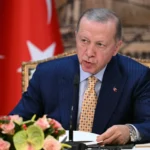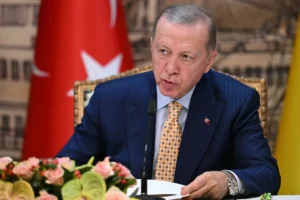Felix Sater has been cast as a Russian mafioso, a career criminal, and a key business associate of President Donald Trump’s — but he spent more than two decades as an intelligence asset who helped the US government track terrorists and mobsters. “Greed is my go-to weapon.”
In the sprawling Trump-Russia investigation, one name constantly pops up: Felix Sater. In story after story, Sater is described as Donald Trump’s former business partner, a convicted stock swindler who was born in the Soviet Union, worked in Russia, tried to win Trump a deal in Moscow, and even helped broker a Ukrainian peace plan that Vladimir Putin would have loved.
Basically, he’s portrayed as something just short of a Russian spy.
Effectively, he has been a spy — but for the United States. For the first time, BuzzFeed News has verified the surprising sweep of Sater’s undercover work and many of his specific exploits. He worked as an asset for the CIA and the Defense Intelligence Agency (or DIA) and tracked Osama bin Laden. Then he worked for more than a decade for the FBI, providing intel on everything from the mob to North Korea’s drive for nuclear weapons. He still operates as a source for the bureau, according to two current FBI agents.
He did some of this work to fend off prison time after he admitted guilt in a stock scam — but he had started helping the US government before then, and he continued to report back to the FBI after the agreement ended. Today, as he is being questioned about Trump’s business deals and ties to Russia, he has built relationships with at least six members of special counsel Robert Mueller’s team, some going back more than 10 years.
“At the direction of the FBI,” Sater traveled to the Middle East after 9/11 to collect “valuable intelligence” on “key leaders in al Qaeda.”
Fragments of Sater’s work for the government have leaked out, partly because Sater himself has bragged about “building Trump Towers by day and hunting Bin Laden by night.” But his “cloak-and-dagger claims of chasing down terrorists” were often dismissed as “wildly unlikely,” while Sater himself remained “an obsession of the many investigators — professional and amateur — searching for Trump’s Russia connection.”
Now BuzzFeed News has obtained the statement Sater gave under oath to House Intelligence Committee investigators at his attorney’s office in December, interviewed him extensively, and corroborated many details of his spy-thriller account through legal documents, emails, letters, and interviews with 10 current and former law enforcement and intelligence officials familiar with his undercover work.
“At the direction of the FBI,” the Department of Justice stated in a newly unsealed court filing, Sater traveled to the Middle East after 9/11 to collect “valuable intelligence” on “key leaders in al Qaeda,” and he helped “in a number of other areas, including Russian organized crime.” In other court filings, the Justice Department said Sater’s work on behalf of the United States “involves 18 foreign governments” as well as “various families of La Cosa Nostra,” and that his help was “of an extraordinary depth and breadth.”
Specific exploits confirmed by BuzzFeed News include:
- He obtained five of the personal satellite telephone numbers for Osama bin Laden before 9/11 and he helped flip the personal secretary to Mullah Omar, then the head of the Taliban and an ally of bin Laden, into a source who provided the location of al-Qaeda training camps and weapons caches.
- In 2004, he persuaded a source in Russia’s foreign military intelligence to hand over the name and photographs of a North Korean military operative who was purchasing equipment to build the country’s nuclear arsenal.
- Sater provided US intelligence with details about possible assassination threats against former president George W. Bush and secretary of state Colin Powell. Sater reported that jihadists were hiding in a hut outside Bagram Air Base and planned to shoot down Powell’s plane during a January 2002 visit. He later told his handlers that two female al-Qaeda members were trying to recruit an Afghan woman working in the Senate barbershop to poison President Bush or Vice President Dick Cheney.
- He went undercover in Cyprus and Istanbul to catch Russian and Ukrainian cybercriminals around 2005. After the FBI set him up with a fake name and background, Sater posed as a money launderer to help nab the suspects for washing funds stolen from US financial institutions.
The CIA, DIA, FBI, and leaders of the House Intelligence Committee all declined to comment.
Over the past month, two BuzzFeed News reporters met frequently with Sater in Los Angeles, where he’s been living since February and which seems to suit him. He’s tan. He had his Porsche shipped over from Long Island. He gets the good table at Delilah, a see-and-be-seen West Hollywood nightclub. He said he is telling his full story, long kept secret by the government, to clear his name. “I am being given no choice because of the ongoing Trump investigations,” he said. “The media lies about me.”
“The media lies about me.”
The revelations about his clandestine work for the United States complicate an already complicated figure, revealing a man who thrives on mixing espionage, politics, and business, often playing one off the other to his own advantage.
Sater, who recently turned 52, started out as a stockbroker who lost his license after he assaulted a man in a bar brawl. He helped scam investors out of tens of millions of dollars in the mid-1990s. He later emerged as a partner to the Trump Organization and a senior advisor to Trump himself, raising money for the future president and his family on projects such as Trump SoHo, the troubled hotel that nearly led to fraud charges against Ivanka Trump and her brother Donald Jr.
Trump Moscow
Even as he was helping US intelligence and law enforcement agencies, Sater racked up enemies in his business dealings. An Arizona man said Sater threatened to cut his legs off during a failed development deal. Florida investors said his company, Bayrock, ripped them off. A former colleague said in a lawsuit that the entire Bayrock operation was run by organized crime figures, and that Sater threatened to have him killed if he didn’t cooperate. Sater denied doing any of these things.

But he doesn’t deny that he is always looking for an angle. As the Trump campaign kicked into high gear in 2015, Sater saw an opportunity.
In emails initially revealed by the Washington Post, Sater wrote to Trump’s longtime personal lawyer, Michael Cohen, boasting about being able to finally line up a real estate development in Moscow — a deal the Trump Organization had long sought.
In one of the emails, Sater told Cohen that he could get buy-in from Putin himself and that “we will get Donald elected” in the process. Those emails have become a flashpoint in the Trump-Russia investigation — but Sater, who denied having anything to do with Russian interference in the election, told BuzzFeed News he was just doing what he’s always done: working a deal.
Did he actually know Putin?
“No, of course not.”
Did he think the Trump Moscow deal could get Trump elected?
Even Trump “is fucking surprised he became the president.”
Then why send that email?
“If a deal can get done and I could make money and he could look like a statesman, what the fuck is the downside, right?”

“The dark side of Wall Street”
Born in the Soviet Union but an American citizen raised in Brooklyn, Sater was a Wall Street wunderkind who worked at top shops such as Bear Stearns and Shearson Lehman Brothers. He was whip-smart but also a hothead, and, one night in 1991, a drunk Sater got into an argument at a Midtown bar with a commodities broker. The man was coming after Sater with a beer bottle, Sater said, so he grabbed a margarita glass and hit the man in the face with it. Both men were hospitalized afterward, but Sater’s opponent took the worst of it: a badly slashed face that led to Sater spending a year in prison for felony assault.
Got a tip? You can email tips@buzzfeed.com. To learn how to reach us securely, go to tips.buzzfeed.com.
Worse still, he was stripped of his broker’s license and became persona non grata on Wall Street. To make money, he helped start a company that purported to buy and sell Nasdaq stocks. In reality, it was an elaborate and illegal “pump and dump” stock scheme that defrauded investors out of nearly $40 million, according to court records.
Brokers, paid under the table, purchased stocks through offshore accounts controlled by Sater. Sater’s firm spun false stories about the companies to inflate their value, then dumped the overpriced stocks onto unwitting investors. Court documents show that the five main New York City mafia families were directly involved, mostly to provide muscle.
“They were there for disputes,” Sater said.
After working on what he called “the dark side of Wall Street” for 18 months, Sater said he left the business in 1995 because he “didn’t want to do dirty shit anymore.” The next year, he went to Russia to work on telecommunications deals with AT&T and others. One night, Sater was at dinner with a group of Russians in Moscow when he was introduced to an American defense contractor named Milton Blane. Sater said Blane, who died last year, followed him into the restroom that night and asked for his phone number to set up a meeting the following day.
“I want you to understand: If you’re caught, the USA is going to disavow you and, at best, you get a bullet in the head.”
At an Irish pub, Blane explained that he worked for the DIA and that some of the people Sater had been dining with were high-level Russian intelligence agents. “‘You’re in with a group who could deliver,’” Sater recalls Blane telling him. Blane, Sater said, asked him to work as an asset, intelligence lingo for a confidential source, but warned, “‘I want you to understand: If you’re caught, the USA is going to disavow you and, at best, you get a bullet in the head.’”
Sater’s fluent Russian, his business connections, and his access to Russian military officials would have made him a prime recruitment target for any US intelligence agency in Moscow, two longtime intelligence officers said. But they also said Blane’s approach was unorthodox — recruits wouldn’t usually be told they would be disavowed, and a counterintelligence investigation would normally have taken place to ensure Sater wasn’t working for an enemy.
In any event, the Moscow meeting with Blane launched Sater’s work for the government, which would last for the better part of two decades. He said he was not paid for his work — which two Justice Department officials confirmed — but did it to help his country and for the “thrill.”
One of Sater’s early operations involved the pursuit in 1998 of Stinger anti-aircraft missiles. The CIA had originally given the missiles to the mujahideen to oust the Soviets during their occupation of Afghanistan — but now the agency wanted to prevent them from falling into the hands of radicalized jihadists. Sater managed to find some, complete with their serial numbers.
Sater’s attorney, Robert Wolf, said he acted as his conduit to the CIA. As Wolf tells it, he called someone he had long known: David Kendall, Bill Clinton’s lawyer, telling him that he had serial numbers for the Stinger missiles that the Clinton administration had been trying to obtain. Kendall, Wolf said, called back and said he had spoken with President Clinton and that Wolf should call Robert M. McNamara Jr., the CIA’s general counsel. During the phone call with McNamara, Wolf read out the serial numbers for the Stinger missiles.
CIA officials were skeptical, so Sater provided photographs of the missiles — with their serial numbers and a copy of a daily newspaper to prove the photo was current.
But, intelligence sources told BuzzFeed News, CIA officials were skeptical. So Sater provided photographs of the missiles — with their serial numbers and a copy of a daily newspaper to prove the photo was current. Two former intelligence officers and an FBI agent confirmed that Sater had provided the photographs, an incident they said bolstered his credibility.
Meanwhile, Wolf recalled, McNamara brokered a meeting at a restaurant near the CIA headquarters in Langley, Virginia, which was attended by Wolf and two employees of the CIA’s clandestine division: an operations officer and an attorney named Steve Hermes. For the next year or so, Wolf said, he talked regularly with Hermes by pay phone or landline when Sater wanted to pass on new information — or when the CIA wanted more intelligence. “We just went back and forth for months and months about al-Qaeda, bin Laden, and the return of the Stingers,” Wolf said.
Hermes, who has retired from the CIA, and Clinton’s spokesperson did not respond to requests for comment. Kendall declined to comment. McNamara Jr. died in 2013.
In August 1998, President Bill Clinton authorized Operation Infinite Reach — a bombing strike against al-Qaeda in retaliation for the terror attacks on the US embassies in Kenya and Tanzania, which killed 224 people. Sater, 10 current and former intelligence and law enforcement officials said, supplemented US intelligence by providing location coordinates for al-Qaeda camps that the US military ultimately bombed in Khost, Afghanistan.
BuzzFeed News also confirmed another 1998 mission, in which Sater infiltrated the Afghan precious stone market to find dealers who were laundering money for al-Qaeda. Sater found his own dealer, from New York City’s 47th Street diamond district, and brought him to the Middle East to make the ruse seem more authentic. An FBI source said the Justice Department later confirmed this detail in court filings that remain under seal. BuzzFeed News reviewed an internal government document about the mission in which an intelligence official characterized the information Sater passed on as “highly sensitive intelligence.”
But while Sater developed contacts and filtered information for America’s spies, back at home the FBI was starting to ask questions about his past.

Sater in Dubai in May, 1998. Obtained by BuzzFeed News
Bin Laden’s phone numbers
One day in 1998, while Sater was living in Russia, a NYPD official called the FBI with an unusual tip: In a Manhattan storage locker, the police had discovered a shotgun, two pistols, and a gym bag containing a cache of documents tied to Sater.
Raymond Kerr, in charge of the FBI’s Russian organized crime task force, went down to the NYPD station to check out the records. What he found was shocking: The documents showed the inner workings of the pump-and-dump scheme, which involved more than a dozen traders and muscle from the Italian mob. Immediately, Kerr and another agent, Leo Taddeo, began hunting for Sater.
Sater was vacationing in Italy when the Afghan intelligence officer called with five satellite phone numbers belonging to bin Laden.
As the FBI closed in, Sater continued to work his contacts overseas. He developed a close bond with an intelligence officer working for the Northern Alliance, the Afghan militia led by Ahmad Shah Massoud, the fierce and beloved fighter called the Lion of Panjshir. As the Northern Alliance fought Islamists, its intelligence officer fed information to Sater, according to Sater and a former FBI agent.
Late in 1998, Sater was vacationing in Italy with his family when the Afghan intelligence officer called with five satellite phone numbers belonging to bin Laden. He asked Sater to pass the numbers along to officials in the US.
Then the FBI found Sater and told him he was under investigation for the stock fraud. “I never intended on fighting and I surrendered,” Sater told BuzzFeed News. “I knew I was going to cooperate.”
Sater flew back to New York City, and at his first meeting with Taddeo, the FBI agent, Sater played his trump card, turning over a piece of scrap paper on which he had jotted down bin Laden’s satellite phone numbers.
Sater pleaded guilty to racketeering in December 1998. But instead of being sentenced, Sater, like 16 other defendants in the case, signed a cooperation agreement with the US government, and his entire case file was sealed.
Signing Sater’s cooperation agreement for the Department of Justice was Andrew Weissmann, then an assistant US attorney and now a key member of the special counsel’s team. Mueller himself would be the FBI director for most of the time Sater served as a source.
“For more than 10 years, he worked with prosecutors providing information crucial to national security.”
The US attorney who oversaw Sater’s pump-and-dump case was Loretta Lynch, later the attorney general under President Barack Obama. While the Senate was considering her confirmation, Sen. Orrin Hatch asked Lynch about how her office handled Sater’s fraud case. In a written response, she said:
“The defendant in question, Felix Sater, provided valuable and sensitive information to the government during the course of his cooperation, which began in or about December 1998. For more than 10 years, he worked with prosecutors providing information crucial to national security and the conviction of over 20 individuals, including those responsible for committing massive financial fraud and members of La Cosa Nostra. For that reason, his case was initially sealed.”
To the government, he was no longer Felix Sater; in public he was referred to as John Doe, while in hundreds of pages of FBI interview reports, his code name was “The Quarterback.”
“Greed is my go-to weapon”
Sater was driving into Manhattan one fall morning when traffic ground to a halt on a ramp to the Queens–Midtown Tunnel. In the distance, he saw smoke rising from lower Manhattan.
The 9/11 attacks shook Sater, and his law enforcement and intelligence handlers urged him to find any information he could.
Sometimes, he said, he threatened people, but most of the time he used a different approach: “I’m not that big of a guy and I don’t carry a gun. Greed is my go-to weapon. I knew how to tap into that emotion. I would convince them that they’re going to make a lot of money with me.”
He said he told a former Russian intelligence official that the two of them could run banks together and make $200 million. To the Northern Alliance source who had provided bin Laden’s satellite numbers, Sater said he went one step further, persuading the man that he would become the “Alan Greenspan of Afghanistan” and run the country’s federal reserve after the US invasion.
Sater said he set up Delaware LLCs in the US — for the “Bank of Kabul” and the “Bank of Afghanistan.” He registered websites to convince the Northern Alliance source that he was serious about his intentions, going so far, he said, as to print out the corporate registrations, adorn them with ribbons, and use a wax stamp to make them seem more official. He said he mailed the documents, and a satellite phone, to the source.
Two former Justice Department officials said Sater took these steps without the FBI’s knowledge or authorization, telling his handlers about it only after the fact.
Sater’s source had his own source: Mullah Omar’s personal secretary, who was living inside a cave with bin Laden.
But soon, according to three former FBI agents, an intelligence official, and a Department of Justice official, Sater reported back to intelligence agencies on the results of coalition bombings, kills on the battlefield, the financial networks behind the 9/11 bombers and other al-Qaeda members worldwide, and even the identity of a New Mexico company believed to be laundering terror funds in the US.
Sater’s Afghan intelligence source funneled to him copies of al-Qaeda passports, jihadi escape routes, the locations of fighters, and weapons caches. He described the source as a “gold mine” — but it was only much later that Sater learned that the information originated inside al-Qaeda’s hideouts. According to a former senior Justice Department official and a former FBI agent with knowledge of Sater’s work, Sater’s source had his own source: Mullah Omar’s personal secretary, who was living inside a cave with bin Laden.
In most cases, Sater would turn over information and never know what, if anything, the US did with it. But Raymond Kerr, a former FBI agent in charge of investigating organized crime in New York City and who used Sater as a key source, said the intelligence Sater provided was valuable. “We wouldn’t have gone to bat for him the way we did if his information wasn’t good and we couldn’t corroborate it,” Kerr said.
Said another top intelligence official who worked directly on terror cases before and after 9/11, “Felix likely does not realize how important his work has been in saving American lives. What he did on behalf of the US for more than a decade outweighs any of the bad deeds from his youth.” Sater, the official said, “deserves a commendation.”
Doing deals for Trump
Sater was under orders to keep his government work secret. He changed his last name to “Satter” to avoid scrutiny from internet sleuths, and the details of his participation in the stock fraud were kept sealed from the public.
The first hints emerged in a little-read book, The Scorpion and the Frog, written by one of Sater’s partners in the stock fraud. In it, author Salvatore Lauria wrote about his adventures with Sater in Russia and elsewhere for the CIA. Sater was referred to as “Lex Tersa” (“Tersa” is an anagram of “Sater”) but the book didn’t take off and his history as an intelligence asset remained largely hidden.
“I’m going to be the biggest developer in New York City — and you want to be my partner.”
But a new partnership would put him in business with one of the most famous people in America — Donald Trump.
Sater and his partners, including Tevfik Arif, a Kazakh real estate baron, started a company called Bayrock Group and sought to finance real estate projects across the globe. Bayrock rented office space in Trump Tower, and one afternoon the ever-confident Sater said he knocked on Trump’s office door and introduced himself: “I’m going to be the biggest developer in New York City — and you want to be my partner.”
Bayrock began to work with the Trump Organization on licensing deals in which Trump earned a fee by doing little more than giving his name to the project, while others put up the money and actually built the property. Sater and Trump are pictured celebrating deals together across the globe, and Sater accompanied Ivanka Trump and her brother Don Jr. on a trip to Russia.
But the good times stopped rolling when a 2007 article in the New York Times outed Felix’s involvement in the pump-and-dump scheme and his “tangled past.” Investors, unaware of Sater’s criminal background, questioned his involvement with Bayrock. Banks pulled back from doing business with the company, and his partners squeezed him. “I had to leave the company that I built with my own hands,” he said.
He left the US and spent two years working in Russia with a large real estate developer, the Mirax Group. He worked on two projects in London, he said, including a group of townhouses near Regent’s Park that made “good money.”

“Trying to rehabilitate myself”
In 2009, 11 years after he formally started cooperating, the US government was finally going to hold up its end of the bargain. Sater headed to a federal courthouse in Brooklyn in October 2009 for his sentencing in the stock fraud scheme.
Two federal prosecutors and four FBI agents showed up to vouch for him. A transcript of that hearing is heavily redacted, but it makes clear that Sater was no ordinary cooperating witness.
“There was nothing he wouldn’t do,” former assistant US attorney Todd Kaminsky, now a New York state senator, told the judge. “He was really helpful and was the key to open a hundred different doors.”
“There was nothing he wouldn’t do.”
Taddeo, his main FBI handler, said that Sater’s work damaged the Bonanno crime family and helped the FBI take La Cosa Nostra out of the Wall Street stock business.
“The length of his cooperation is extraordinary,” said Marshall Miller, another assistant US attorney. “And I wanted to be here to express from the office’s perspective just how capable a cooperator he was, how important a cooperator he was, and how effective he was.”
Taddeo, who left the FBI in August 2015 and now works for a private cybersecurity firm, did not respond to phone and email messages. Kaminsky said he couldn’t comment because much of the case was still sealed, and Miller, who has left the Justice Department, also declined to comment.
Finally, it was Sater’s turn to face the judge. “Yes, I am guilty of the things that I have done,” he said. But, he added, “I am trying to rehabilitate myself.”
US District Court Judge I. Leo Glasser, who had sentenced dozens of people to prison based on information Sater had provided to the FBI, told him, “For 11 years, I would suspect you had gone to bed every night or every other night sleeping a little restlessly and wondering what your sentence is going to be. So, in effect, there has been a sentence which already has been imposed.”
“Donald said, ‘Where have you been?’”
For the $40 million scheme, Sater was fined $25,000.
To this day, Sater continues to cooperate with the FBI and Justice Department, he said in his statement to the House Intelligence Committee. He wouldn’t disclose additional details, except to say that he works on “international matters.” Two US officials confirmed Sater continues to be a reliable asset.
As for his regular life, when he relocated back to the US in 2010, he recalled, “Donald said, ‘Where have you been?’” Sater said Trump asked him to join the Trump Organization. “That’s when I became senior advisor to him,” he said. The Trump Organization and the White House declined to comment.
Ukrainian Peace Plan
When Trump won the presidency, Sater saw an opportunity to do what he does best: make deals. But his ambition backfired, putting Sater in the middle of the Trump-Russia scandal.
In early 2017, Sater told BuzzFeed News he was trying to close a deal with a Ukrainian politician and others on an energy deal in Eastern Europe. Sater estimated he and his partners could earn billions. But as they closed in, the Ukrainian, Andrey Artemenko, asked Sater for a favor: Could he broker a meeting with Trump’s team to discuss a “peace plan” for Ukraine and Russia?
The deal, which Sater said set out a way to lift sanctions on Russia, surely would have pleased the Kremlin, but it would have been a sharp departure from previous US policy. Still, Sater summoned Trump’s personal lawyer, Cohen, to a Midtown Manhattan hotel in February 2017, and Artemenko gave him a letter about the plan. Cohen has denied passing the plan to the White House and told BuzzFeed News he threw it out.
“I thought everybody wins. Turns out, I lost.”
Where some see the meeting as foreign interference in US policy, Sater sees opportunity. If he could grease the skids with a potential business partner while bringing peace to a war-torn region, Sater said, who could argue with that? “No more war,” Sater said. “People not getting killed. Beautiful situation.”
But the encounter is now reportedly part of the special counsel’s investigation, and Sater finds himself in the spotlight. Of the Ukrainian plan, Sater said, “I thought everybody wins. Turns out, I lost.”
Sater has already been summoned by congressional investigators, and he is expected to speak to the Senate Intelligence Committee in April. He also has been questioned by Mueller’s team, several of whom he knows from his past undercover work. It’s almost certain that Sater has sensitive information about Trump’s business dealings, but he won’t say what he was asked or what information he provided. The special counsel’s office declined to comment for this story.
The glare of the Trump-Russia investigation, he said, has taken its toll: His marriage of 29 years collapsed, his reputation is mud among his business friends, and he has recently been the subject of anti-Semitic messages and phone calls from neo-Nazi groups.
He hopes that by revealing the extent of his cooperation, he will be able to change how the public — and his own family — thinks about him. Meanwhile, he presses on without the support of Trump, whom Sater said he considered a good friend.
Trump has denied knowing the man who had an office three doors down from his own and who helped his company explore deals across the globe. In a 2013 deposition, Trump said of Sater, “If he were sitting in the room right now, I really wouldn’t know what he looked like.”
Over dinner last week at the Beverly Hills Hotel, Sater was clearly hurt when he spoke about the president’s statement. “It’s very upsetting but, you know, what am I going to do?” Sater said. “Start calling him a liar?” Sater said he hasn’t talked with Trump in a couple of years, but he sees an angle to keeping in Trump’s good graces.
“First thing I plan to do when Trump leaves office, whether it’s next week, in 2020 or four years later, is march right into his office and say, ‘Let’s build Trump Moscow.’
“I’m serious.” ●















